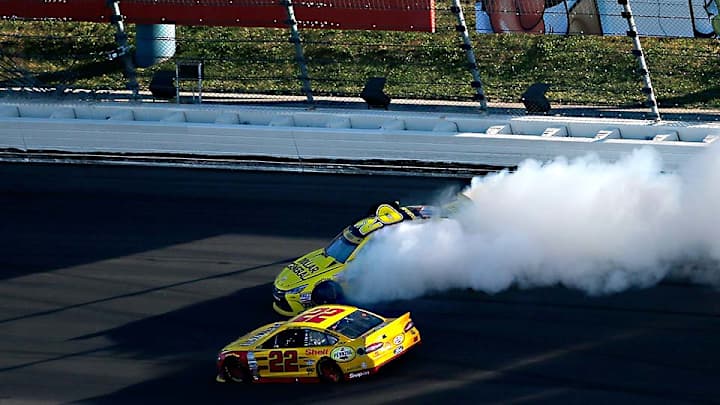Joey Logano's spin of Kenseth raises Chase decorum questions

KANSAS CITY, Kan. (AP) — Joey Logano scoffed at the seemingly unwritten rule that you don’t spin someone when you’re already guaranteed of advancing in the Chase for the Sprint Cup championship.
After all, as he pointed out after sending fellow title contender Matt Kenseth for a ride at Kansas Speedway, “NASCAR does the rules. I just drive the race car.”
That attitude raised plenty of questions over Chase decorum, though.
Logano had won the opening race of the “contender” round at Charlotte, so he had nothing to lose in Sunday's race. Kenseth had a miserable finish and arrived at Kansas knowing that he would need to win there or this coming weekend at Talladega to earn a spot in the next round.
Everything looked like it was playing out perfectly for him, too. Kenseth had his No. 20 Toyota at the front all day, leading a race-high 153 laps, and had a spot in the eight-driver “eliminator” round within sight with five laps to go. But by that point, Logano had the faster car, and had spent the last 10 laps glued firmly to his rear bumper.
Kenseth was doing everything he could to protect the lead, and Logano finally got fed up with a series of blocks. With a good run going into Turn 1, Logano stuck his nose under Kenseth's rear fender, and one of the Chase favorites was suddenly sliding across the track.
“He ran me hard. I ran him hard back,” Logano explained. “Unfortunately, those things happen, right? It doesn’t take anything away from our team. I’m proud of what this team is doing.”
Kenseth tends to be low-key, but the spin heard `round NASCAR rubbed him the wrong way.
“He just plain wrecked me,” Kenseth said. “He cries on his radio a lot, I guess, about blocking or moving around, but man, you’re leading the race and you can pick whatever lane you want. It’s not like he was alongside me. To wreck somebody for being in a lane that you wanted to be in seems kind of risky and not very smart. That was a decision he made.”
It was risky in two entirely different ways.
For one thing, Logano could have spun himself out, too. But with a spot in the next round already assured, that hardly mattered.
More importantly, Logano risked irking other drivers with plenty of Chase races left.
He heads to unpredictable Talladega this weekend once more with nothing to lose, but things reset the following week at Martinsville. Logano will have everything to lose as the Chase hits the homestretch, while Kenseth—assuming he doesn’t win at Talladega to keep his own title hopes alive—will be the one who has nothing to lose.
In other words, Logano may have to watch his back the rest of the way.
“He’s got to race the guys around him,” team owner Roger Penske said. “Each one of these drivers know the circumstances, and they’re going to make the moves that are necessary to try to get ahead. ... To me, that’s going to be the pattern as we go the next four or five races.”
In the aftermath of Sunday, two distinct camps emerged.
Some sided with Kenseth, claiming that Logano made a move for the lead in the No. 22 that was aggressive at best, malicious at worst. Others sided with Logano, arguing that he was racing to win, taking the “have at `em, boys” approach that NASCAR has encouraged the past few years.
“I don't know what that mentality is,” said Denny Hamlin, one of Kenseth’s teammates at Joe Gibbs Racing. “I’m sure from the 22 standpoint, he didn’t want the 20 to win. That’s one of the faster cars in the Chase. If you can eliminate someone like that, he’s trying to do that.
“It’s a mix there,” Hamlin said. “One guys has to win and another has nothing to lose.”
NASCAR chairman Brian France sided with Logano, calling the move “quintessential NASCAR” during an interview on SiriusXM radio. France said it was “a great example of everybody doing probably exactly what they should be doing”—two drivers racing for the win.
It’s part of the tension produced by an elimination-style playoff format.
“I think the Chase format was designed to create tension, to create competition and certainly pressure on the teams and the drivers,” Penske said.“From the standpoint of the way they drive on the track, you just have to watch the restarts and see that it’s elbows-out-the-window there every time. ... I think the format is terrific.”
